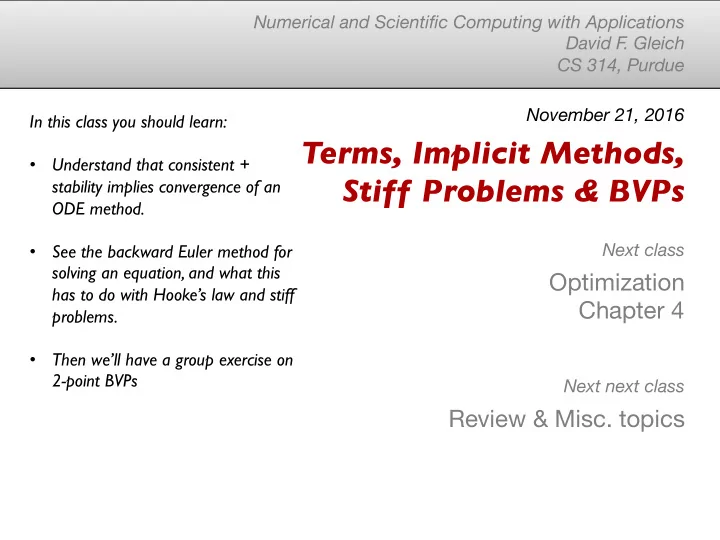

Numerical and Scientific Computing with Applications David F . Gleich CS 314, Purdue November 21, 2016 In this class you should learn: Terms, Implicit Methods, • Understand that consistent + Stiff Problems & BVPs stability implies convergence of an ODE method. Next class • See the backward Euler method for solving an equation, and what this Optimization has to do with Hooke’s law and stiff Chapter 4 problems. • Then we’ll have a group exercise on 2-point BVPs Next next class Review & Misc. topics
Convergent ODEs y k +1 = y k + h step [ y k , t , h ] • The global error of an approximation is: Worst approx at k =1,..., N k y k � y ∗ ( t k ) k . max any time point • A scheme step is convergent if global error ! 0 as h ! 0.
Convergent ODEs y k +1 = y k + h step [ y k , t , h ] • The global error of an approximation is: Worst approx at k =1,..., N k y k � y ∗ ( t k ) k . max any time point • A scheme step is convergent if global We want this! error ! 0 as h ! 0. • All schemes step we look at in this class are stable Just a technical notion of “super-continuous” • The local truncation error of step is 1 h ( y ∗ ( t + h ) − y ∗ ( t )) − step [ y ∗ ( t ), t , h ]
Convergent ODEs y k +1 = y k + h step [ y k , t , h ] • A method is consistent if h → 0 step [ y k , t , h ] = f ( y k , t ). lim Theorem 11.2.2 If a method is consistent and stable with local truncation error O ( h p ), then the global error is O ( h p ) and the method is conver- gent. Corollary If a method is consistent and stable, then it is convergent.
Forward Euler is Convergent y k +1 = y k + h step [ y k , t , h ] Step for FE step [ y k , t , h ] = f ( y k , t ) Stability by Prof. assertion & guarantee. Hence, this is convergent! By THEOREM y ∗ ( t + h ) = y ∗ ( t ) + h d dt y ∗ ( t ) + O ( h 2 ) 1 h ( y ∗ ( t + h ) − y ∗ ( t )) = d dt y ∗ ( t ) + O ( h ) = f ( y ∗ ( t ), t ) + O ( h ) = step [ y ∗ ( t ), t , h ] + O ( h ) So local truncation error is O(h) and so is Global Error!
Convergent Absolute Stability • Fixed time window! • Infinite time window • EXTREMELY large • One specific equation constants. y k → 0 for dy dt = λ y when Re( λ ) < 0 • Just an asymptotic statement Global Error -> 0 as h -> 0 in some window [0,T]
Hooke’s Law 0 � d y 1 dt = y − k 0 | {z } = A √ λ ( A ) = ± ki Im( z ) Re( z ) z = λ h
Implicit Methods & Backward Euler Consider our derivation of Forward Euler We get the step 1 h ( y ( h ) − y (0)) ≈ y . / dt = f ( y (0), 0) from this idea, then iterate! The following is just as valid! Use backwards in 1 time instead of . / dt = f ( y ( h ), h ) h ( y ( h ) − y (0)) ≈ y foreword approx. i.e. the derivative holds at the unknown future Using this idea requires us to implicitly assume that we known y ( h ) and solve for its value.
Implicit Methods & Backward Euler Backward Euler Given y k , solve This is, generally speaking, very y k + h f ( x , t k +1 ) − x = 0 hard to do! for x and set y k +1 = x . (This is a nonlinear equation that we’ll see how to solve in the next class) d y Backward Euler for dt = A y Given y k , solve This is often much y k + h A x − x = 0 ⇔ ( � − h A ) x = y k easier to do! for x and set y k +1 = x . (This is a linear equation!)
Why use implicit methods? • Much better stability properties for long time integration! e.g. The region of absolute stability for backwards Euler is � � 1 � � � < 1 � � 1 − h λ � Im( z ) Everything Not Re( z ) z = λ h else is valid! valid!
Example of Backwards Euler Juliabox!
Why use implicit methods? • They work better for Stiff Problems! These are problems where Foreward Euler would need a very small time-step. (Last 3 mins of class!)
Now! Team exercise on BVPs! • Organize into small reading groups • Work through as much of the BVP notes as you can. Ask questions! There may be typos! You really do know this material at this point!
Recommend
More recommend